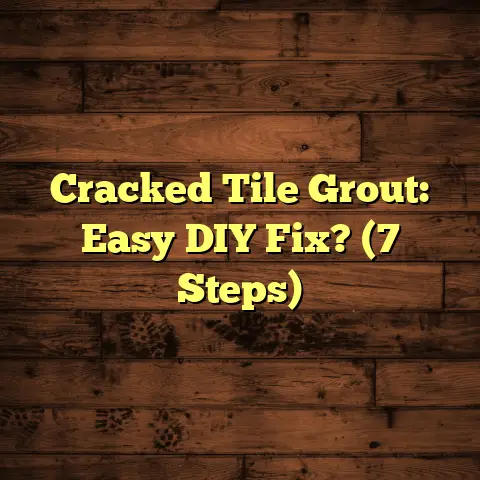Can I Put Laminate Wood Floors In Bathroom? (Explained)
Can I put laminate wood floors in the bathroom? Have you ever stepped into a bathroom with that fresh, clean look, where the flooring somehow ties everything together? I certainly have, and it got me thinking about the choices we make when it comes to flooring materials in spaces that experience moisture.
When I first started my journey as a flooring contractor, I had clients who were excited about installing laminate wood floors everywhere, including bathrooms. I remember one job vividly. A young couple wanted their new home to have a cohesive look, and they insisted on using laminate in the bathroom. They loved the warmth and aesthetic appeal of wood but were worried about water damage.
The Allure of Laminate in a Bathroom
Laminate flooring is popular for its affordability and extensive design options. It mimics the look of hardwood without the hefty price tag, plus it’s easy to install. However, the bathroom is a unique space. With showers, sinks, and tubs, water is always present, and that raised a flag for me.
One of the key things I learned was that not all laminate flooring is created equal. Some are more water-resistant than others. When considering this material for a bathroom, I always recommend looking for laminate specifically designed for high-moisture areas. These products often have added moisture barriers that can prevent warping or swelling.
My Experience with Laminate in Bathrooms
In my early years as a contractor, I took on a project that involved renovating a small bathroom in an older home. The homeowner was passionate about sustainability and wanted to use eco-friendly materials. We chose a high-quality laminate with a water-resistant core.
Installation went smoothly, and the overall aesthetics were fantastic. The couple was thrilled with their new floor, which resembled rich oak but cost significantly less than actual hardwood. However, a few months later, I received a call from them. They noticed some minor swelling near the edges of the laminate planks.
Lessons Learned
This experience taught me the importance of proper installation and maintenance. Sealing the edges during installation can help prevent moisture from seeping in. I always advise my clients to maintain proper ventilation in their bathrooms, especially after showers and baths.
I also found that using rugs or mats can help absorb excess moisture and protect the laminate from potential damage. This simple addition can extend the life of your flooring considerably.
Cost Consideration
When discussing costs with clients, I often rely on tools like FloorTally to provide accurate estimates. For that bathroom project, I input all details, including room dimensions and laminate specifications. FloorTally helped me calculate not only the material costs but also labor expenses.
For instance, if laminate costs around $2-$5 per square foot and installation runs about $1-$3 per square foot, the total project cost could range significantly based on the size of the bathroom. With FloorTally’s insights, we were able to present a comprehensive budget that included everything from underlayment to finishing touches.
Comparing Options
While I love laminate for its affordability and variety, I’ve also seen a few challenges. Tile is another popular option for bathrooms because it’s impervious to water damage. However, it can be cold underfoot and more expensive to install.
So how do you choose? If you’re set on installing laminate in your bathroom, ensure it’s a product rated for high moisture areas. On the other hand, if you prefer durability and don’t mind spending a little more, tile might be the way to go.
Installation Tips
If you decide to go with laminate for your bathroom, here are some practical tips:
- Choose Water-Resistant Laminate: Always check the specifications before purchasing.
- Seal the Edges: Use silicone caulk around the perimeter and any seams. This helps keep moisture out.
- Maintain Ventilation: Install exhaust fans or leave windows open during showers to reduce humidity.
- Use Rugs: Place mats strategically to absorb excess water.
- Regular Cleaning: Avoid using excessive water when mopping; instead, opt for damp mops.
Maintenance Matters
Maintaining laminate flooring in a bathroom requires careful attention but is manageable with the right approach. Avoid abrasive cleaners that can scratch the surface, and stick to gentle products designed for laminate.
One time, I had a client who used vinegar on their laminate floor thinking it would clean effectively; however, it led to dullness in finish over time. Instead, I recommend using mild soap mixed with water for regular cleaning.
Challenges I Faced
During various installations, I’ve encountered challenges like uneven subfloors or incorrect underlayment choices leading to squeaks or gaps between planks. Rectifying these issues can be labor-intensive but is crucial for longevity.
In one instance, we installed laminate over an old vinyl floor without checking its condition first. It seemed like a time-saver initially, but soon those imperfections became apparent as the laminate began to shift slightly underfoot.
The Importance of Proper Installation Techniques
As any seasoned contractor will tell you, proper installation techniques can make or break your flooring project.
Preparing the Subfloor
The first step involves ensuring that the subfloor is level and dry. If there are any dips or peaks in the subfloor, those need to be evened out before proceeding with laminate installation. I’ve learned that even minor imperfections can lead to significant issues down the line.
In one project, I found an unexpectedly uneven concrete slab while prepping for installation. It was a bit of a setback, but addressing it before laying down the laminate saved us from future headaches.
Acclimation Period
Another critical aspect is allowing your laminate planks to acclimate to the room’s temperature and humidity before installation. This usually involves leaving them in the bathroom for 48 hours prior to starting work. This step can prevent expansion or contraction after installation—something that could lead to gaps or buckling later on.
Understanding Different Types of Laminate Flooring
Not all laminate flooring is created equal, especially when discussing moisture resistance. Here are some types I’ve worked with:
- Standard Laminate: Generally not recommended for bathrooms due to its vulnerability to water damage.
- Water-Resistant Laminate: Designed specifically for areas prone to moisture; these products often have an additional layer that helps repel water.
- Waterproof Laminate: This is a step up from water-resistant options and offers superior protection against spills and humidity.
Each type serves different needs and budgets, so when advising clients, I always help them assess what fits their lifestyle best.
Real-Life Client Stories
I’ve had many clients who were unsure about using laminate in their bathrooms due to potential risks. One family decided to take the plunge after seeing a beautiful installation I had done in another home.
They chose a high-quality waterproof laminate that mimicked distressed barn wood. The transformation was stunning! They loved how it brightened up their small space while providing a comfortable surface underfoot.
However, they took my advice seriously regarding maintenance and ventilation. Installing an exhaust fan was one of their first steps after the remodel was complete, which significantly reduced humidity levels after showers.
Environmental Considerations
For homeowners concerned about environmental impact, many laminate options today are made from recycled materials and are free of harmful chemicals like formaldehyde. During one project, I had a client who was passionate about sustainable living and insisted on eco-friendly options.
We found a waterproof laminate certified by environmental standards. Not only did it provide durability for their bathroom, but it also aligned with their values of reducing environmental impact.
What About Transition Strips?
When installing laminate in a bathroom adjacent to other flooring types (like tile or vinyl), transition strips become necessary. These pieces help cover gaps between different flooring materials while providing a smooth transition from one surface to another.
I once worked on a project where we used an elegant aluminum transition strip that added a modern touch while keeping things functional. These details matter when creating cohesive designs!
Budgeting Your Bathroom Flooring Project
Budgeting is crucial when it comes to any home improvement project. To give you an idea of costs:
- Laminate Flooring: $2-$5 per square foot
- Installation Costs: $1-$3 per square foot
- Additional Materials (underlayment, transition strips): $1-$2 per square foot
For example: If you’re working on a 100-square-foot bathroom:
- Material costs could range between $200-$500
- Installation costs might add another $100-$300
- Additional materials could run around $100-$200
- Total estimated cost: $400-$1000
Using FloorTally simplifies this process remarkably well by providing detailed estimates based on precise measurements and selections made for your project.
Troubleshooting Common Issues
Even with careful planning and execution, issues can arise during or after installation:
- Moisture Problems: If you notice signs of warping or buckling post-installation, check for leaks or high humidity levels in your bathroom.
- Scratches or Damage: Using mats at entry points can minimize scratches from footwear or pet claws.
- Gaps Between Planks: Fluctuations in temperature and humidity can cause gaps. In such cases, review your acclimation process or ensure proper expansion gaps were left during installation.
These troubleshooting tips have helped me navigate many issues over the years and keep my clients satisfied with their installations.
Conclusion: Making Informed Choices
Putting laminate wood floors in your bathroom can be an excellent choice if done correctly with consideration for moisture levels and installation practices.
If you’re leaning toward this option:
- Choose high-quality water-resistant or waterproof laminate.
- Ensure proper installation techniques are followed.
- Maintain good ventilation and care practices post-installation.
Reflecting on my journey as a flooring contractor has taught me countless lessons about materials and client needs alike. So whether you’re embarking on your own project or just exploring options, feel free to reach out! What are your thoughts on using laminate in your bathroom? Let’s chat about what you envision!





